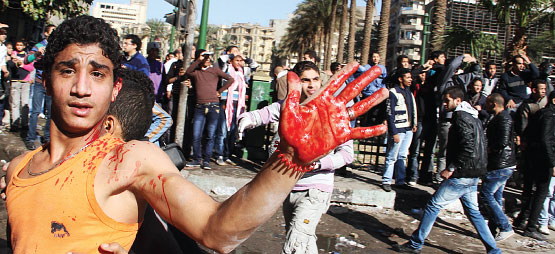On the Ground: Tahrir Square
One year after the first wave of the Egyptian revolution in January and February 2011, we take a look back at how it all began. Steven Cook offers an inside perspective on what it was like to be in Tahrir Square during those first tumultuous days.

I arrived at a moment that was very, very scary, because they were sending in reinforcements of the central security forces—black-clad guys with helmets, shields, and not just batons but metal pipes. And these enormous trucks, one after another were discharging all these soldiers. The recruits were 17 or 18 years old and were from rural areas of Egypt. They lined up against the protestors and beat them—people about the same age or maybe a little bit older than they were. Then these trucks, which are notorious for not having any brakes, followed the crowd at high speeds. This is the way in which they pushed everybody back into the square, because protesters had been splayed out about a quarter of a mile down the road from Tahrir Square to the parliament. As I watched this thing unfold, I thought I was going to see people die that night. But, thankfully, there was minimal bloodshed.
There were spectators; people were hanging out of their buildings. This was the first night so people didn’t know what was going to happen. I spoke to some people on the sidelines who were just watching. They said that they agreed with what the protestors were demanding but they were too afraid because of what might happen.
You don’t realize it, when there’s traffic, how enormous Tahrir Square is—it’s just enormous—and it was about half-full at that time. There’s a grassy circle in the middle and it was full up to that end. There was a really festive atmosphere, and people were feeling the freedom to say nasty things about Mubarak, the family, and the regime.
I met one of Egypt’s most famous writers in the square, Dr. Alaa Al Aswany, a dentist who had written the popular book The Yacoubian Building. [The novel tells the stories of people living in a Cairo apartment building during Hosni Mubarak’s dictatorship.] In a country that is not known for voracious reading, it sold 60,000 copies. Al Aswany told me, “You are witnessing the first night of the Egyptian Revolution,” which was extraordinary because nobody knew for sure that the regime would come crashing down.
So it was an exhilarating experience to be there, but a scary one. The Egyptian police had a reputation for being brutal. There were moments when the crowd would get whipped into a frenzy, and I was never sure how the police were going to react. And, as I said, spectators were coming from around the city.
Around midnight, the water cannons and tear gas began to fly, and the troops cleared the square, which seemed to me to be a mistake from a purely tactical perspective, because during the mass uprisings in 1968 and 1972, the government had left people in the square for days, negotiated with them, and it came to an end.
But this regime was arrogant to the core. Just a few weeks before the protests, President Mubarak had opened the parliament, and the opposition discussed establishing a shadow government to demonstrate to Egyptians what a real democratic parliament would look like. Mubarak waved his hand and said, “Well, let them have fun.” It was an amazing epitaph for his time in power.
